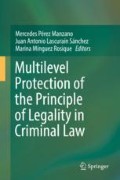Abstract
Foreseeable, according to the Dictionary of the Spanish Royal Academy, is “What may be foreseen or comes within normal foresight”. To foresee is “To see in anticipation” or “To know, to conjecture by some signs or indications what has to happen” or “To have or to prepare resources against future contingencies”.
Professor of Philosophy of Law at Universidad de León.
Access this chapter
Tax calculation will be finalised at checkout
Purchases are for personal use only
Notes
- 1.
I have not failed to notice that in this example there is a change in the conditions under which the sentence is to be served, but not in its duration. I mention this to point to the need for general solutions rather than purely casuistic ones. On the unclear barrier between the punishment and its duration, Díaz Crego (2013), pp. 587–588, writes that “If a clear difference can formally be established between the punishment and the modalities of its enforcement, that borderline loses clarity in those circumstances in which the modality of its enforcement implies a notable aggravation of the punishment, i.e. a significant lengthening of its duration”.
- 2.
For the same or similar reasons to those set out by Hava García (2014), p. 155: “As this stage now, it should appear an incontrovertible fact that both life imprisonment and the death penalty are senseless in the prevention of terrorist attacks, as these are usually committed by hardened criminals, who show themselves impervious to what is called positive general prevention”.
- 3.
In the opinion of Díaz Gómez (2013), p. 27: “a significant sector of the doctrine, which probably constitutes the majority, has considered that changes in case-law, even detrimental ones, should not be included in the guarantee of the non-retroactivity of unfavourable norms. In this way, the courts maintain their margin for interpretation, preventing the immobility entailed in the impossibility of modifying the previous exegesis of the norm”.
- 4.
- 5.
Llobet Anglí (2015), p. 13.
- 6.
On this point and in the case involved in the ruling of the ECtHR, we should bear in mind what is well explained by Rodríguez Montañés (2014), p. 140: “It has to be borne in mind that the full or partial discharge of sentences, computation of benefits and the definitive release of offenders (that is the time at which the computation of sentence reductions for prison work takes effect) are not questions of which the Supreme Court is cognizant, because the decision is made by the organ responsible for the enforcement of the sentence and the appeal that is legally foreseen against its decisions is a petition for appeal against that organ itself. The Parot case reached the Supreme Court because it was a case of the “recasting” or accumulation of sentences, an admissible question for cassation as expressly foreseen in art. 988 LECrim. In fact, the Supreme Court did not admit cassation against the decisions of the sentencing Courts regarding definitive release, until its criterion changed the Court Order of 7th April 2008”.
- 7.
It has been said that the ECtHR in its judgement widened the concept of penalty for the effects of art. 7.1 of the Convention (Díaz Gómez (2013), p. 27). In truth, the widening extended to three questions: the concept of penalty, the concept of legality (with the inclusion of favourable case-law within the “legality” which is protected by the principle of legality) and the time at which the expectation that is favourable to the offender arises, which is not necessarily, it appears, the time at which the offence is committed. On this final question, see my article: García Amado (2014), pp. 61 and ff.
References
Cuerda Arnau ML (2013) Cambios jurisprudenciales y retroactividad desfavorable (a propósito de la STEDH del Río Prada c. España). Revista Penal 1:52–69
Díaz Crego M (2013) Cuando Parot llegó a Estrasburgo. Teoría y realidad constitucional 31:573–612
Díaz Gómez A (2013) La «doctrina Parot» y sus aspectos formales y constitucionales: a propósito de la Sentencia de 21 de octubre de 2013 del TEDH. Revista General de Derecho Penal 20:1–29
García Amado JA (2014) Sobre algunas consecuencias de la sentencia del TEDH en el caso Del Río Prada contra España: irretroactividad de la jurisprudencia penal desfavorable y cambios en las fuentes de producción del Derecho penal. El Cronista del Estado Social y Democrático de Derecho 41:54–63
Hava García E (2014) Antes y después de la doctrina Parot: la refundición de condenas y sus consecuencias. Eunomia Revista en Cultura de la Legalidad 6:153–173
Llobet Anglí M (2015) No sólo imprevisible, también irrazonable: otra vez sobre la «doctrina Parot». Indret 2:1–32
Rodríguez Montañés T (2014) Doctrina Parot: claves para entender las sentencias del TEDH en el caso Del Río Prada c. España Eunomia Revista en Cultura de la Legalidad 6:137–152
Author information
Authors and Affiliations
Corresponding author
Editor information
Editors and Affiliations
Rights and permissions
Copyright information
© 2018 Springer International Publishing AG
About this chapter
Cite this chapter
Amado, J.A.G. (2018). On the Principle of Criminal Legality and Its Scope: Foreseeability as a Component of Legality. In: Pérez Manzano, M., Lascuraín Sánchez, J., Mínguez Rosique, M. (eds) Multilevel Protection of the Principle of Legality in Criminal Law. Springer, Cham. https://doi.org/10.1007/978-3-319-63865-2_10
Download citation
DOI: https://doi.org/10.1007/978-3-319-63865-2_10
Published:
Publisher Name: Springer, Cham
Print ISBN: 978-3-319-63864-5
Online ISBN: 978-3-319-63865-2
eBook Packages: Law and CriminologyLaw and Criminology (R0)

